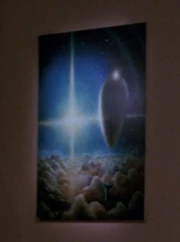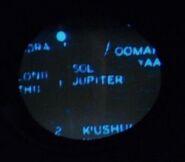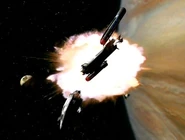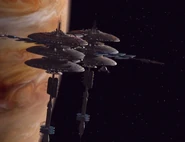No edit summary |
(changed spelling of V'Ger to V'ger) |
||
| (4 intermediate revisions by 2 users not shown) | |||
| Line 6: | Line 6: | ||
| Class= [[Gas giant|Gas Giant]] |
| Class= [[Gas giant|Gas Giant]] |
||
| Type= [[Planet]] |
| Type= [[Planet]] |
||
| − | | Satellites= |
+ | | Satellites= [[Ganymede]] and [[Io]], plus many other moons |
| Native Species= None |
| Native Species= None |
||
| Location= [[Sol system]]<br />[[Sector 001]]<br/>[[Alpha Quadrant]] |
| Location= [[Sol system]]<br />[[Sector 001]]<br/>[[Alpha Quadrant]] |
||
| Line 13: | Line 13: | ||
{{disambiguation|the Roman god|Jupiter (mythology)}} |
{{disambiguation|the Roman god|Jupiter (mythology)}} |
||
{{disambiguation|the automobile|Jupiter 8}} |
{{disambiguation|the automobile|Jupiter 8}} |
||
| − | '''Jupiter''' (also known as '''Sol V''') was the [[fifth planets|fifth]] and largest [[planet]] of the [[Sol system]]. The planet was noticeable for the |
+ | '''Jupiter''' (also known as '''Sol V''') was the [[fifth planets|fifth]] and largest [[planet]] of the [[Sol system]]. The planet was noticeable for the Great Red Spot, its many moons, and bands of cloud layers. This [[gas giant]] was located near to the {{dis|asteroid belt|Sol system}}. ({{TOS|The Changeling|By Any Other Name}}; {{VOY|Future's End}}; {{film|1}}; {{film|12}}) |
== Location == |
== Location == |
||
The [[Coordinates|spatial coordinates]] in [[orbit]] of the inner moon [[Io]] were 23.17.46.11. ({{film|12}}) |
The [[Coordinates|spatial coordinates]] in [[orbit]] of the inner moon [[Io]] were 23.17.46.11. ({{film|12}}) |
||
| − | |||
| − | Published in [[1990]], ''The Solar System'' was a reference poster, with a description of the Sol system's origins, planetary data on its nine planets, and brief descriptive comments on the minor bodies, for students and astronomers. The poster included a large illustration of the system that depicted the orbit of Jupiter. Some of the major [[moon|natural satellite]]s were shown in orbit above this planet. This poster was displayed on a wall in the office where [[Rain Robinson]] worked, at the [[Griffith Observatory]]. ({{VOY|Future's End}}) The poster was also displayed on the wall of the [[classroom]] on [[Deep Space 9]] in [[2370]]. ({{DS9|Cardassians}}) |
||
In [[2267]], the position and orbital path of Jupiter were depicted on ''Chart 14A: The Sol System'', stored in the {{USS|Enterprise|NCC-1701}} library computer. The chart was scanned by the [[probe]] [[Nomad]] in [[Auxiliary Control]]. ({{TOS|The Changeling}}, ''production art'') |
In [[2267]], the position and orbital path of Jupiter were depicted on ''Chart 14A: The Sol System'', stored in the {{USS|Enterprise|NCC-1701}} library computer. The chart was scanned by the [[probe]] [[Nomad]] in [[Auxiliary Control]]. ({{TOS|The Changeling}}, ''production art'') |
||
| − | In the [[2270s]], the |
+ | In the mid-[[2270s]], the {{USS|Enterprise|NCC-1701}} traveled through the inner system of the Jovian system. Later, a star chart that labeled the location of Jupiter in a neighborhood of astronomical objects, stored in the ''Enterprise'' library computer, was scanned by ''[[V'ger]]''. ({{film|1}}, ''production art'') |
<gallery> |
<gallery> |
||
| Line 42: | Line 40: | ||
According to [[Arex]], the [[cosmic cloud]] encountered by the {{USS|Enterprise|NCC-1701}} in [[2269]] was twice the diameters of Jupiter, [[Saturn]], and [[Neptune]] in size. ({{TAS|One of Our Planets Is Missing}}) |
According to [[Arex]], the [[cosmic cloud]] encountered by the {{USS|Enterprise|NCC-1701}} in [[2269]] was twice the diameters of Jupiter, [[Saturn]], and [[Neptune]] in size. ({{TAS|One of Our Planets Is Missing}}) |
||
| − | In the [[2270s]], the ''Enterprise'' flew past Jupiter on its way to intercept ''[[V' |
+ | In the [[2270s]], the ''Enterprise'' flew past Jupiter on its way to intercept ''[[V'ger]]''. ({{film|1}}) |
By the early [[24th century]] a [[shuttle]] route had been established "''from Jupiter to [[Saturn]] and back, once a day, every day,''" know as "''the [[Jovian Run]].''" Both [[Edward Jellico]] and [[Geordi La Forge]] used to [[pilot]] shuttles on this route early in their [[Starfleet]] careers. ({{TNG|Chain of Command, Part II}}) |
By the early [[24th century]] a [[shuttle]] route had been established "''from Jupiter to [[Saturn]] and back, once a day, every day,''" know as "''the [[Jovian Run]].''" Both [[Edward Jellico]] and [[Geordi La Forge]] used to [[pilot]] shuttles on this route early in their [[Starfleet]] careers. ({{TNG|Chain of Command, Part II}}) |
||
Revision as of 11:09, 9 August 2014
AT: "xx"
Jupiter (also known as Sol V) was the fifth and largest planet of the Sol system. The planet was noticeable for the Great Red Spot, its many moons, and bands of cloud layers. This gas giant was located near to the asteroid belt. (TOS: "The Changeling", "By Any Other Name"; VOY: "Future's End"; Star Trek: The Motion Picture; Star Trek Into Darkness)
Location
The spatial coordinates in orbit of the inner moon Io were 23.17.46.11. (Star Trek Into Darkness)
In 2267, the position and orbital path of Jupiter were depicted on Chart 14A: The Sol System, stored in the USS Enterprise library computer. The chart was scanned by the probe Nomad in Auxiliary Control. (TOS: "The Changeling", production art)
In the mid-2270s, the USS Enterprise traveled through the inner system of the Jovian system. Later, a star chart that labeled the location of Jupiter in a neighborhood of astronomical objects, stored in the Enterprise library computer, was scanned by V'ger. (Star Trek: The Motion Picture, production art)
History
Before the invention of the telescope, Humans had discovered this planet in the night sky. (TNG: "Loud As A Whisper", okudagram)
In the late 1970s, this planet was surveyed by Pioneer 11, which discovered the planet's magnetic field and magnetosphere. (TNG: "Loud As A Whisper", okudagram)
In 2143, the NX-Alpha was destroyed near Jupiter shortly after breaking the warp 2 barrier. By 2151, Jupiter Station in orbit of Jupiter served as a repair facility to Earth Starfleet and the Earth Cargo Service. (ENT: "Silent Enemy", "Fortunate Son", "First Flight", et al.)
In 2259 of the alternate reality, the USS Vengeance was launched from the Io Facility, a spacedock in orbit of the moon Io. (Star Trek Into Darkness)
A close-up image of Jupiter was contained in the library computer aboard the USS Enterprise. This image was flashed on a viewscreen when the Talosians scanned the Enterprise computer in 2254. (TOS: "The Cage" remastered)
According to Arex, the cosmic cloud encountered by the USS Enterprise in 2269 was twice the diameters of Jupiter, Saturn, and Neptune in size. (TAS: "One of Our Planets Is Missing")
In the 2270s, the Enterprise flew past Jupiter on its way to intercept V'ger. (Star Trek: The Motion Picture)
By the early 24th century a shuttle route had been established "from Jupiter to Saturn and back, once a day, every day," know as "the Jovian Run." Both Edward Jellico and Geordi La Forge used to pilot shuttles on this route early in their Starfleet careers. (TNG: "Chain of Command, Part II")
In 2367, Jupiter Outpost 92 reported visual contact of a Borg cube at 12:13. (TNG: "The Best of Both Worlds, Part II")
Tours of the lava flows on its third moon were popular by 2377. (VOY: "Life Line")
Template:SolSystem
Appendices
Background information

A balloon-borne craft in the atmosphere of Jupiter
Jupiter as seen in the TNG opening sequence
A painting seen in several episodes aboard the USS Enterprise-D was originally created by Rick Sternbach to illustrate a (non-Trek) science fiction story called "The Anvil of Jove". As such, it depicts a plane-like craft tethered to a balloon, cruising the atmosphere of Jupiter. [2]
Star Trek: Deep Space Nine set decorations mention the Jupiter Mining Corporation, which may be associated with this planet.
The chart of Sol/Jupiter in relation to nearby astronomical objects seen in Star Trek II: The Wrath of Khan was taken from page T0:02:07:02 of the Star Fleet Technical Manual by Franz Joseph.
According to Star Trek: Star Charts (Pgs. 22, "United Federation of Planets I"), Jupiter was classified as a J-class planet. This planet was a charter member of the United Federation of Planets in 2161.
Jupiter is one of the planets seen in the opening sequence of Star Trek: The Next Generation beside the Earth, Luna, Sol, and Saturn, shortly before the Enterprise-D started its exploration of the unknown space.
External links
- Template:NCwiki
- Jupiter at Wikipedia
- Moons of Jupiter at Wikipedia



